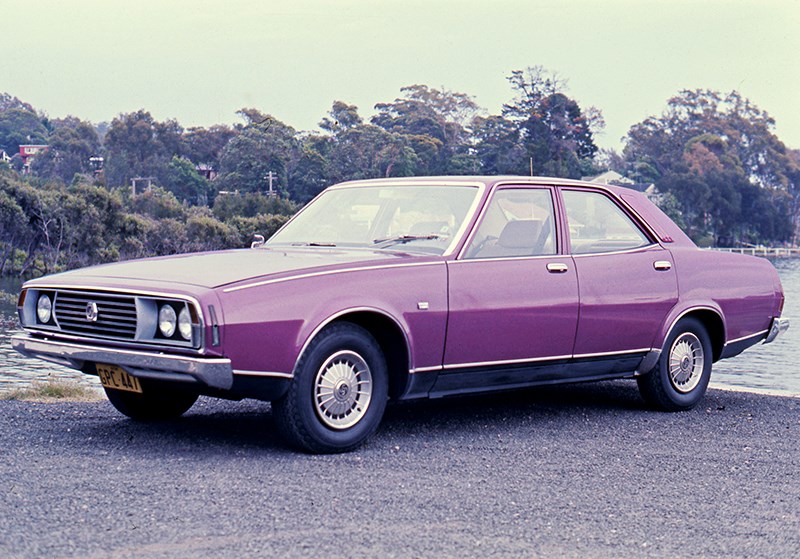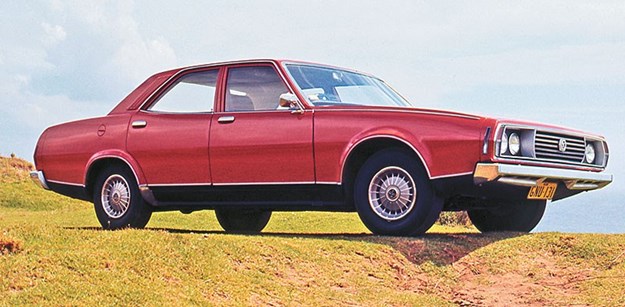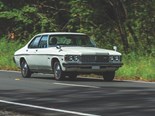1973-1975 Leyland P76 V8 - Buyer's Guide



|
It was meant to take on the big three. It failed, but its legacy was a brilliant V8 engine
Only 17,000 of Leyland’s P76 were built and most won’t have had more than a few owners. Nevertheless, every second person in the country seems to have an opinion on the car and few are positive.
Fact is, the P76 was one of the most enlightened designs of its age and one that continues to bring joy to the people who today own surviving P76s. Problem was, the P76 was a big car launched at the time we were being told to downsize. It was also being built by people who, in a lot of cases, shouldn't have been let anywhere near a production line.
The car that appeared in 1973 should have been a thumping success. It won that year’s Wheels ‘Car Of The Year’ and orders flooded in. However, the factory was underprepared and lots of buyers got sick of waiting.
| Read next: 1974 Leyland P76 Targa Florio

The shape was created in conjunction with Leyland styling consultant Giovanni Michelotti who had been told, possibly in jest, that the boot needed to hold a 44-gallon (205 litre) drum and the interior should be able to accommodate six big Aussies.
A few P76s were built as six-seaters and some found work in the cab industry. However, most had separate front seats plus a big, low-set bench in the back that gave smaller children the impression that they were sitting on the floor.
The basic engine was a 2.6-litre six-cylinder but the car looked way too big for such a puny powerplant and many buyers felt obliged to specify the optional V8.
| 2021 Market Review: Leyland 1971-1983

Despite being physically larger than all its competitors except the VJ Valiant, the P76 in Super trim with a V8 engine weighed only 1287kg. With 4.4 litres propelling such a lightweight body, the four-speed manual should have been a jet, but its performance was strangled by a single exhaust and undersized carburettor.
Road tests when the V8 was new managed 0-96km/h in 8.9 seconds, with fuel consumption of 17L/100km. Later in life, with their cylinder heads modified and a four-barrel carb plus dual exhaust installed, these cars would shave two seconds off the acceleration time and still use less fuel than the standard engine. A two-door Force 7 coupe that was meant to deliver such performance never reached production.
One special version did appear, but only 488 were built. It was named ‘Targa Florio’ in honour of the car, crewed by former BMC PR boss Evan Green and the late John Bryson, which tackled the 1974 World Cup rally. It ran for a large part of its journey through the Sahara desert and it was there that the P76 tumbled out of contention, but not before it had beaten every other car in the event to win a winding and dangerous Targa Florio special stage.

Joining the ranks of P76 owners will usually involve membership of a club (of which there are several) or happening upon a car offered for sale via social networking or in regional newspapers.
Four-speed V8s attract significant money, but don’t overlook a 3-speed column shift V8 as these can be adapted to accept the ‘single-rail’ gearbox.
A lot of P76s have undergone complete restorations but keeping them running can involve compromises in the area of authenticity. With some components unavailable, resourceful owners have found ways to replace them with something adapted from another brand.
Value range Leyland P76 (V8 4-Speed)
Fair: $6500
Good: $13,500
Excellent: $21,000
((Note: exceptional cars will demand more)

BUYER'S CHECKLIST
Body & chassis
Lightweight construction and poor rust-proofing sent lots of Leylands to early graves. Wheel-arches, lower front mudguards, the bonnet and boot-lid are common spots for bubbling. However, the real car killers are rusty inner sills, extending into the centre pillar, suspension mounts and window surrounds. Structural parts generally need to be made and that gets expensive although Club sources can supply some items including door skins, lights, a brand-new grille and used bumpers. Check that the rear window is firmly sealed and isn’t leaking water. Also look under the boot mat and spare wheel well for rust.

Engine & transmission
Inadequate or defective cooling systems allow cylinder heads to warp, causing oil leaks and blown gaskets. Make sure that the radiator is free of oil scum and there is no milky residue under the oil filler cap or dipstick. Early cars cracked piston skirts and rings causing damage to cylinder liners. The problem should have by now been resolved in surviving cars but still be wary of rattling noises when the engine is revved and exhaust smoke. The Borg-Warner four-speed gearbox was shared with other vehicles including some Fords and the Chrysler Charger. Second-hand gearboxes range in price from $450-1000 and parts remain available. Fitting a twin-plate Charger clutch can eliminate the shudder experienced by V8 owners.
Suspension & brakes
P76 springs were criticised for being too soft but when in good condition they do an excellent job of smoothing bumps while keeping the body relatively flat through bends. Original equipment shock absorbers were awful but they will all be long gone. If the car bounces excessively on rough surfaces or ‘floats’ on smooth roads, allow $600-800 for some decent shocks. Also have a look at bushings, especially at the rear where the trailing arms need to be securely mounted. Front discs are adequate but if you’ve added some pep to the engine a rear disc conversion using Falcon parts is possible.
Interior & electrics
Trim was vinyl on most versions and easily replaced. The ‘Level 4’ Executive had a special cloth covering which is difficult to match. Door trims appear occasionally in the classifieds but if the car isn’t ‘concours’, a retrim with material that closely resembles the original cloth of vinyl will get you out of trouble. Dash switches seem easy to find but there has been for some time a shortage of column-mounted indicator stalks. Repairs are possible using Valiant parts, but the process is fiddly.
1973-1975 Leyland P76 V8
NUMBER MADE: 7870 (V8s)
BODY STYLES: Steel integrated body/chassis four-door sedan
ENGINE: 4416cc V8 with overhead valves & single downdraft carburettor
POWER & TORQUE: 143kW @ 4250rpm, 387Nm @ 2500rpm
PERFORMANCE: 0-96km/h 8.9 seconds, 0-400 metres 16.7 seconds (V8 4-speed)
TRANSMISSION: Three-speed automatic, three or four-speed manual
SUSPENSION: Independent with coil springs, MacPherson struts & anti-roll bar (f) Live axle with coil springs. locating links and telescopic shock absorbers (r)
BRAKES: Disc (f) drum (r) power assisted
TYRES: 185HR14 radial
From Unique Cars #469, Aug/Sep 2022
Unique Cars magazine Value Guides
Sell your car for free right here
Get your monthly fix of news, reviews and stories on the greatest cars and minds in the automotive world.
Subscribe

.jpg)








.jpg)
.jpg)


